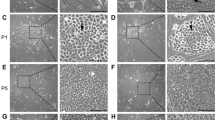Abstract
The androgen receptor (AR) is a validated therapeutic target for prostate cancer and has been a focus for drug development for more than six decades. Currently approved therapies that inhibit AR signaling, such as enzalutamide, rely solely on targeting the AR ligand-binding domain and, therefore, have limited efficacy on prostate cancer cells that express truncated, constitutively active AR splice variants (AR-Vs). The LNCaP95 cell line is a human prostate cancer cell line that expresses both functional full-length AR and AR-V7. LNCaP95 is a heterogeneous cell population that is resistant to enzalutamide, with its proliferation dependent on transcriptionally active AR-V7. The purpose of this study was to identify a LNCaP95 clone that would be useful for evaluating therapies for their effectiveness against enzalutamide-resistant prostate cancer cells. Seven clones from the LNCaP95 cell line were isolated and characterized using morphology, in vitro growth rate, and response to ralaniten (AR N-terminal domain inhibitor) and enzalutamide (antiandrogen). In vivo growth of the clones as subcutaneous xenografts was evaluated in castrated immunodeficient mice. All of the clones maintained the expression of full-length AR and AR-V7. Cell proliferation of the clones was insensitive to androgen and enzalutamide but importantly was inhibited by ralaniten, which is consistent with AR-Vs driving the proliferation of parental LNCaP95 cells. In castrated immunodeficient animals, the growth of subcutaneous xenografts of the D3 clone was the most reproducible compared to the parental cell line and other clones. These data support that the enzalutamide-resistant LNCaP95-D3 subline may be suitable as a xenograft tumor model for preclinical drug development with improved reproducibility.





Similar content being viewed by others
References
Ware KE, Garcia-Blanco MA, Armstrong AJ, Dehm SM. Biologic and clinical significance of androgen receptor variants in castration resistant prostate cancer. Endocr Relat Cancer. 2014;21(4):T87–T103. https://doi.org/10.1530/ERC-13-0470.
Lu C, Brown LC, Antonarakis ES, Armstrong AJ, Luo J. Androgen receptor variant-driven prostate cancer II: advances in laboratory investigations. Prostate Cancer Prostatic Dis. 2020. https://doi.org/10.1038/s41391-020-0217-3.
Chandrasekar T, Yang JC, Gao AC, Evans CP. Targeting molecular resistance in castration-resistant prostate cancer. BMC Med. 2015;13(1):206. https://doi.org/10.1186/s12916-015-0457-6.
Chen CD, Welsbie DS, Tran C, Baek SH, Chen R, Vessella R, et al. Molecular determinants of resistance to antiandrogen therapy. Nat Med. 2004;10(1):33–9. https://doi.org/10.1038/nm972.
Antonarakis ES, Lu C, Wang H, Luber B, Nakazawa M, Roeser JC, et al. AR-V7 and resistance to enzalutamide and abiraterone in prostate cancer. N Engl J Med. 2014;371(11):1028–38. https://doi.org/10.1056/NEJMoa1315815.
Joseph JD, Lu N, Qian J, Sensintaffar J, Shao G, Brigham D, et al. A clinically relevant androgen receptor mutation confers resistance to second-generation antiandrogens enzalutamide and ARN-509. Cancer Discov. 2013;3(9):1020–9. https://doi.org/10.1158/2159-8290.CD-13-0226.
Li Y, Chan SC, Brand LJ, Hwang TH, Silverstein KA, Dehm SM. Androgen receptor splice variants mediate enzalutamide resistance in castration-resistant prostate cancer cell lines. Cancer Res. 2013;73(2):483–9. https://doi.org/10.1158/0008-5472.CAN-12-3630.
Antonarakis ES, Lu C, Luber B, Wang H, Chen Y, Nakazawa M, et al. Androgen receptor splice variant 7 and efficacy of taxane chemotherapy in patients with metastatic castration-resistant prostate cancer. JAMA Oncol. 2015;1(5):582–91. https://doi.org/10.1001/jamaoncol.2015.1341.
Pienta KJ, Abate-Shen C, Agus DB, Attar RM, Chung LW, Greenberg NM, et al. The current state of preclinical prostate cancer animal models. Prostate. 2008;68(6):629–39. https://doi.org/10.1002/pros.20726.
Horoszewicz JS, Leong SS, Chu TM, Wajsman ZL, Friedman M, Papsidero L, et al. The LNCaP cell line–a new model for studies on human prostatic carcinoma. Prog Clin Biol Res. 1980;37:115–32.
Hu R, Lu C, Mostaghel EA, Yegnasubramanian S, Gurel M, Tannahill C, et al. Distinct transcriptional programs mediated by the ligand-dependent full-length androgen receptor and its splice variants in castration-resistant prostate cancer. Cancer Res. 2012;72(14):3457–62. https://doi.org/10.1158/0008-5472.CAN-11-3892.
Yang YC, Banuelos CA, Mawji NR, Wang J, Kato M, Haile S, et al. Targeting androgen receptor activation function-1 with EPI to overcome resistance mechanisms in castration-resistant prostate cancer. Clin Cancer Res. 2016;22(17):4466–77. https://doi.org/10.1158/1078-0432.CCR-15-2901.
Liu LL, Xie N, Sun S, Plymate S, Mostaghel E, Dong X. Mechanisms of the androgen receptor splicing in prostate cancer cells. Oncogene. 2014;33(24):3140–50. https://doi.org/10.1038/onc.2013.284.
Banuelos CA, Ito Y, Obst JK, Mawji NR, Wang J, Hirayama Y, et al. Ralaniten sensitizes enzalutamide-resistant prostate cancer to ionizing radiation in prostate cancer cells that express androgen receptor splice variants. Cancers. 2020. https://doi.org/10.3390/cancers12071991.
Imamura Y, Tien AH, Pan J, Leung JK, Banuelos CA, Jian K, et al. An imaging agent to detect androgen receptor and its active splice variants in prostate cancer. JCI Insight. 2016. https://doi.org/10.1172/jci.insight.87850.
Wu X, Gong S, Roy-Burman P, Lee P, Culig Z. Current mouse and cell models in prostate cancer research. Endocr Relat Cancer. 2013;20(4):R155–R170170. https://doi.org/10.1530/ERC-12-0285.
Cunningham D, You Z. In vitro and in vivo model systems used in prostate cancer research. J Biol Methods. 2015. https://doi.org/10.14440/jbm.2015.63.
Obst JK, Wang J, Jian K, Williams DE, Tien AH, Mawji N, et al. Revealing metabolic liabilities of ralaniten to enhance novel androgen receptor targeted therapies. ACS Pharmacol Transl Sci. 2019;2(6):453–67. https://doi.org/10.1021/acsptsci.9b00065.
Gibbons JA, de Vries M, Krauwinkel W, Ohtsu Y, Noukens J, van der Walt JS, et al. Pharmacokinetic drug interaction studies with enzalutamide. Clin Pharmacokinet. 2015;54(10):1057–69. https://doi.org/10.1007/s40262-015-0283-1.
Acknowledgements
This work is supported by a grant from the National Cancer Institute of the National Institutes of Health (R01CA105304).
Author information
Authors and Affiliations
Corresponding author
Ethics declarations
Conflict of interest
The authors declare the following conflict of interests: J.K.L, T.T., J.W., and M.D.S. are inventors of technology pertaining to AR N-terminal domain inhibitors, which was licensed by BC Cancer to ESSA Pharma Inc. M.D.S. owns equity in and is a Scientific Advisor for ESSA Pharma Inc. Their interests are reviewed and managed by BC Cancer in accordance with its research conflict of interest policy.
Additional information
Publisher's Note
Springer Nature remains neutral with regard to jurisdictional claims in published maps and institutional affiliations.
Rights and permissions
About this article
Cite this article
Leung, J.K., Tam, T., Wang, J. et al. Isolation and characterization of castration-resistant prostate cancer LNCaP95 clones. Human Cell 34, 211–218 (2021). https://doi.org/10.1007/s13577-020-00435-6
Received:
Accepted:
Published:
Issue Date:
DOI: https://doi.org/10.1007/s13577-020-00435-6




